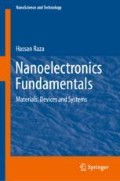Abstract
Memories are used extensively to store information in a binary manner. A memory circuit is a bistable circuit that may be in the high current (low resistance) state or the low current (high resistance) state. One should note that for the use of nanodevices in computing applications, e.g. micro and nanoprocessors, the ON/OFF current ratio has to be four to six orders of magnitude. However, for memory applications, the ON/OFF current ratio requirement is not as stringent. In fact, a ratio of only 10 or less (in most cases) is considered state of the art for the memory technology.
Access this chapter
Tax calculation will be finalised at checkout
Purchases are for personal use only
Notes
- 1.
In fact, it is a group of bits, called a word, that are addressed as a whole. The size of the word depends on the size of the data bus as discussed later.
- 2.
ROMs may also be erasable and/or programmable.
- 3.
Here we assume the FETs as ideal gate operated switches, which have infinite resistance when OFF and zero resistance when ON. However, this is not the case in reality and hence LOW output voltage may be slightly higher than 0 V, and HIGH output voltage may be slightly lower than the supply voltage.
- 4.
Logic level LOW is defined as 0 V, and logic level HIGH is defined as 5 V. Yet another way to define the logic levels is the Boolean notation of logic 0 and logic 1. While, 0 V is usually defined as logic 0 (LOW) and 5 V as logic 1 (HIGH), but this choice is not universal. One could very well define 0 V as logic 1, and 5 V as logic 0.
- 5.
There are indeed some common mode noise elimination methodologies in analog circuits as well.
- 6.
Point C is not used in the memory design due to its inherent instability and lack of noise margin. A memory state stored at point C would ultimately move to either point A or point B depending on the circuit noise.
- 7.
\(\mathcal {D}=K\varepsilon _o\mathcal {E}\).
- 8.
Difference between the threshold voltages for logic 1 and logic 0 states.
Author information
Authors and Affiliations
Corresponding author
Rights and permissions
Copyright information
© 2019 Springer Nature Switzerland AG
About this chapter
Cite this chapter
Raza, H. (2019). Memories. In: Nanoelectronics Fundamentals. NanoScience and Technology. Springer, Cham. https://doi.org/10.1007/978-3-030-32573-2_7
Download citation
DOI: https://doi.org/10.1007/978-3-030-32573-2_7
Published:
Publisher Name: Springer, Cham
Print ISBN: 978-3-030-32571-8
Online ISBN: 978-3-030-32573-2
eBook Packages: Chemistry and Materials ScienceChemistry and Material Science (R0)

